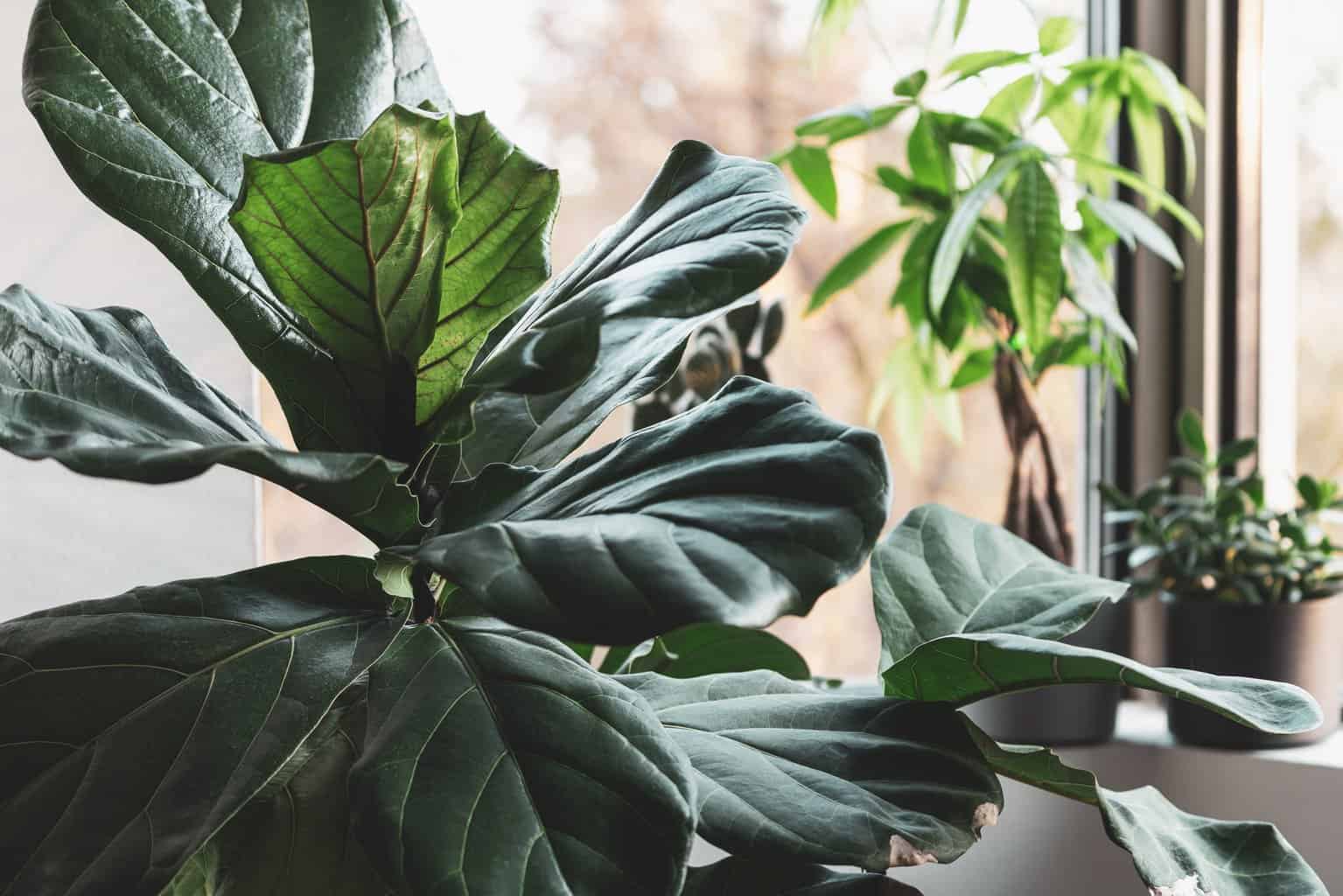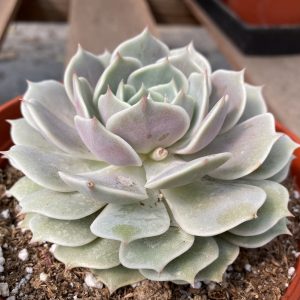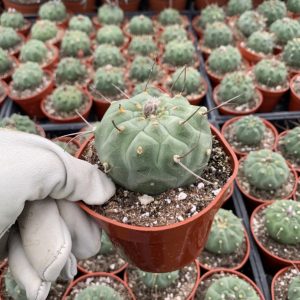No products in the cart.
Table of Contents
One thing about the Ficus lyrata or fiddle leaf fig tree is that it works with the home’s most modern yet simplistic designs. It pairs with neutral colors and the most trendy interior decorations.
With those big waxy violent-shaped leaves, it demands anyone’s attention with the skinny trunk. The bigger they grow, the more eye-catching it becomes. Still, what can go wrong with this beautiful plant?
Well, lots can go wrong but it is not one of your demanding plants. But luckily we are here to help that nothing will go wrong allowing your fiddle leaf figs to thrive.
Some Background History on Fiddle Leaf Figs

The fiddle leaf fig tree comes from West Africa and thrives in warm to wet conditions. So, to some extent, you may feel like a home grower it is a challenging plant to care for. Still, the fiddle leaf is a tough, outdoor plant that can also grow well indoors.
The important thing is to get the fiddle leaf figs growing conditions right, but a bit more on this later. The fiddle leaf can grow up to 50 feet tall in its untamed habitat. Still, grown indoors, they do not reach these heights.
Furthermore, in the wild, this delicate plant drops its seeds where it starts to germinate. When the tree matures, it sends roots down from the canopies into the soil, wrapping around host trees and can strangle them to death.
Another interesting note is that the fiddle leaf fig is related to the rubber tree plants (Ficus elastica) and weeping figs (Ficus benjamina). These plant species do the same thing and are known as strangler figs.
The tree grows evergreen leaves with the shape of a lyre and has a deep green leathery appearance. The underside of the foliage is light and matte, growing up to 18 inches long. Still, a note of warning is that when you slice through the branches and stems, it contains a latex sap that can irritate the skin.
The plant is also very toxic to humans and pets when digested. While you will not get edible fruits when treated as an indoor plant, in their native habitat, the fruit grows up to one inch looking like a fig. On the inside of the fruit, you find off-white flowers that rely on a specific wasp for pollination.
Neither does it produce tasty fruit like its cousin, the Ficus carica.
Ficus Lyrata Tips

As mentioned, it is not a very demanding plant but can be a bit finicky. You will also need to prepare to rotate your fiddle leaf fig weekly so the light can reach different parts of the plant.
Doing this helps prevent your plant standing in a floor-standing container from growing toward the light. Still, also prepare yourself to dust those gorgeous leaves.
The best is using a damp cloth to make it look shinier which helps with photosynthesis from the sunlight.
The Type of Soil Fiddle Leaf Fig Needs

The best soil for your Ficus lyrata is one that contains coconut fibers. The fibers help keep the soil moist and light for a few days. Furthermore, it helps keep the soil intact, preventing it from getting dense with time.
As with other plants, your potting soil must be well–draining, letting excess water run out too fast but should not hold back too much water.
Light Requirement for Ficus Lyrata Plant

Fiddle leaf figs thrive in full sun to partial shade. So it means a bit of direct sunlight from a window in the morning. Ideally, you can place your tree at an east-facing window to bask in bright filtered light all day.
Too much direct sunlight can result in the plant’s leaves burning, turning into brown spots and leaf drops. Neither will a dark place do in a corner as the foliage turns yellow with leaves falling off.
To keep your plant healthy, provide it with bright indirect light to remain glowing.
How To Water Ficus Lyrata to Prevent Root Rot
The biggest challenge you might face with your Ficus lyrata is watering. When the fiddle leaf figs grow in their natural habitat, they can tolerate some drought. So, when in doubt, we recommend leaving the roots on the dry side instead of too wet.
The best is to check the potting mix using your finger, sticking it in about two inches. If the topsoil feels dries but moist a bit further, you need not add water. If it feels dry, then you can water it.
If you notice dark spots on the leaf edges of older leaves, it is a sign of root rot or fungal diseases caused by overwatering. If you see the leaves look wrinkled or drooping, it needs water.
If you feel uncertain about your watering schedule, it helps to invest in a hydrometer that checks the soil moisture. We recommend bottom watering to direct the water to the roots. Another important thing is to use room temperature water and leave the base to soak up the water.
Then leave your fiddle leaf fig to stand to drain the excess water from the drainage holes for about 20 minutes. Also, water around the base of your plant at the soil level and prevent wetting the foliage.
Occasionally, you can water from the top at the soil level to flush out residual salts forming. During winter, you will water less as your tree enters dormancy.
Fertilizer Needs for Ficus Lyrata

For feeding your fiddle leaf fig, we recommend using a balanced, organic fertilizer or liquid fertilizer. Both these feeds work well for your plant. It helps to use a liquid fertilizer during the growing season and the granular one once or twice a year. Your fiddle leaf will do best with a 3-1-2 formulation as it encourages healthy leaves.
Temperature and Humidity Levels
Your fiddle leaf fig might be finicky, but it is for a good reason, as it cannot handle extreme temperature fluctuations.
Hence, we do not recommend exposing your fiddle leaf to temperature fluctuations below 55°F or above 85°F.
The best is to keep your plant away from drafty windows, fireplaces, exterior doors, fans, or radiators. During the winter, when the air is drier in your home, it helps to mist the leaves using a spray bottle.
The best time to mist is in the morning as it gives the foliage time to dry. If you do live in dry climates, it also helps to invest in a humidifier or place a pebble tray underneath your plant.

The Ficus lyrata thrives best in USDA Hardiness Zones 9-11.
Repotting and Propagation
You can expect to replant your fiddle leaf fig every few years. We recommend keeping an eye on the roots growing through drainage holes or circling upwards above the soil line. Still, if you see aerial roots developing above the soil, it does not mean your plant needs repotting.
The best time to transplant your fiddle leaf fig is in spring in a container a couple of inches larger. Once removed from the pot, it helps remove most of the old soil before placing it into a fresh potting medium.
We mentioned it helps to rotate your plant to keep it healthy. Occasionally, you can also prune it when your tree looks uneven. You can do this by removing leaves on the heavy side for a uniform look.
Furthermore, it helps trim the high branches to keep them small and provides proper airflow. Pruning is also significant in removing diseased or damaged leaves. For improved air circulation, you can thin out the crossing branches, but remember to wear gloves.
Fiddle Leaf Fig Propagation
To propagate your fiddle leaf fig is easier to use stem cuttings than planting seeds. You can cut about an 18-inch long stem with a few leaves attached with sharp shears. You can then pinch the leaves off and only leave one leaf in place.
Place your cutting in clean water in a vase or glass and place it in a warm place with bright filtered light. When you see the water becoming cloudy, it helps change the water. In a few weeks, you will notice new growth on the stem, and once it reaches two inches long, you can plant it in some soil.
Ficus Lyrata Varieties
The main fiddle leaf fig species is the Ficus lyrata, but you can also find other cultivars.
Ficus lyrata ‘Bambino’

The fiddle leaf fig is a dwarf variety that only reaches a foot tall.
Ficus lyrata ‘Compacta’

The fiddle leaf fig can reach up to five feet tall and has smaller bunched leaves.
Ficus lyrata ‘Variegata’

The fiddle leaf fig is a rare plant with showy leaves mixed with cream and green.
Ficus Lyrata Diseases and Pests
Okay, now that you have nailed the light, water, temperature, and humidity, you still need to keep an eye on pests and diseases.
Common Insects
First, keep an eye on fungus gnats the size of a fruit fly as the larvae cause the most damage to the roots. It helps to examine the branches and leaves for adults. You will not notice them quickly, but it is time to act if you see a puff of bugs take flight from the soil.
Signs of infestation are wilting plants, and the growth stops while the leaves turn yellow. In addition, you can place sticky traps on stakes above the soil to capture adults. Another helpful thing is to allow the soil to dry between watering.
Another pest is the mealy bug and spider mites that you can treat similarly. For small infestations, you can use a cotton swab with rubbing alcohol to dab on each one. Or you can use an insecticidal spray soap.
Diseases
Botrytis blight is a gray mold with signs of gray or tan spots found on the leaf. The disease comes from too much or too little water and overfeeding your plant. We recommend removing diseased leaves and branches to dispose of in the trash.
Root rot is common in most plants and results from overwatering. It results in dropped leaves, and it is best to examine the roots. The roots will have an unpleasant smell and look mushy.
Still, if you have a tall plant, the best is to dig deep into the soil to feel if it is soggy and mushy. Another telltale sign is brown spots on the leaf edges. But, again, removing the damaged roots and planting them in new soil is best.
Whether you want to buy, sell or simply reach out to other plant enthusiasts, Plantly is the right place to be!
Only 1 left in stock In stock In stock In stock
$29.99
Sold By:
Succulent Oasis
Mature Succulent Plant Echeveria Lola.
Rated 4.84 out of 5 based on 352 customer ratings00
Sold By:
Succulent Oasis
Free Shipping
$44.99
Sold By:
Aloha Hawaii Orchids
Live Paphiopedilum Niveum x Sib (hshyng x tan san) Rare Plant 4″
Rated 4.65 out of 5 based on 268 customer ratings00
Sold By:
Aloha Hawaii Orchids
$15.00
Sold By:
Cacti and Exotica
Matucana madisoniorum
Only 9 available and it’s in 1 people’s basket Rated 4.98 out of 5 based on 59 customer ratings00
Sold By:
Cacti and Exotica
$8.99
Sold By:
BubbleBlooms
Tiger’s jaw, Faucaria tigrina, very rare in 3 inch pot, super filled
Only 41 available and it’s in 3 people’s basket Rated 4.81 out of 5 based on 279 customer ratings00
Sold By:
BubbleBlooms






